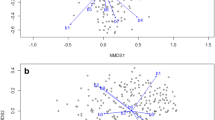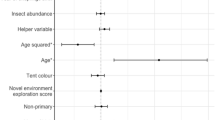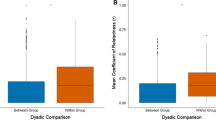Abstract
Individuals consistently differ in their behavior, and such personality differences are often linked to fitness. For biparental care species, the behavior of both parents can impact reproductive success. Behavioral similarity within pairs has been shown to provide selective advantages for many species. In this study, we tested for behavioral similarity in 129 pairs of nesting Canada geese (Branta canadensis) with respect to nest defense behavior, an individually consistent trait. We used a bivariate mixed model to provide unbiased estimates of correlations between partners’ traits. We also tested for the effect of behavioral similarity between mates on reproductive success and predicted greater success for positively assorted pairs. We found that over four consecutive years, pairs of Canada geese were formed of individuals showing similar nest defense intensities. Assortment between mates may result both from personality-dependent non-random mate choice and from behavioral adjustments after pairing that are maintained in the long term. However, behavioral adjustment to a shared environment, among and within breeding seasons, had negligible effects on the covariation between partners’ traits. We also found that similarity in nest defense intensity did not result in higher reproductive success. The factors at the origin of the evolution of long-term behavioral similarity based on nest defense in Canada geese pairs remain to be identified.
Significance statement
Individual consistency in behavioral traits has been demonstrated for many animal species, and its importance in ecology and evolution is now accepted. The maintenance of personality traits in a population may in fact be explained by non-random mate choice like assortative mating, where paired individuals show similar phenotypes. We studied the nest defense behavior, a highly repeatable trait, of 129 Canada goose pairs during four consecutive years and found that paired individuals had similar personalities, suggesting personality-dependent mate choice or post-pairing adjustments maintained in the long term. Our findings also show that the phenotypic similarity between mated individuals is not always related to reproductive success and can possibly result from non-adaptive mechanisms.

Similar content being viewed by others
Data availability
The datasets analyzed during the current study are available from the corresponding author on reasonable request.
References
Araya-Ajoy YG, Mathot KJ, Dingemanse NJ (2015) An approach to estimate short-term, long-term and reaction norm repeatability. Methods Ecol Evol 6:1462–1463
Ariyomo TO, Watt PJ (2013) Disassortative mating for boldness decreases reproductive success in the guppy. Behav Ecol 24:1320–1326
Bell AM, Hankison SJ, Laskowski KL (2009) The repeatability of behaviour: a meta-analysis. Anim Behav 77:771–783
Biro PA, Stamps JA (2008) Are animal personality traits linked to life-history productivity? Trends Ecol Evol 23:361–368
Black JM, Owen M (1995) Reproductive performance and assortative pairing in relation to age in barnacle geese. J Anim Ecol 64:234–244
Black JM, Prop J, Larsson K (2007) Wild goose dilemmas. Branta Press, Groningen
Boon AK, Réale D, Boutin S (2007) The interaction between personality, offspring fitness and food abundance in North American red squirrels. Ecol Lett 10:1094–1104
Both C, Dingemanse NJ, Drent PJ, Tinbergen JM (2005) Pairs of extreme avian personalities have highest reproductive success. J Anim Ecol 74:667–674
Brommer JE, Class B (2017) Personality from the perspective of behavioral ecology. In: Vonk J, Weiss A, Kuczaj S (eds) Personality in nonhuman animals. Springer, Cham, pp 73–107
Burtka JL, Grindstaff JL (2015) Similar nest defence strategies within pairs increase reproductive success in the eastern bluebird, Sialia sialis. Anim Behav 100:174–182
Choudhury S, Black JM, Owen M (1996) Body size, fitness and compatibility in barnacle geese Branta leucopsis. Ibis 138:700–709
Class B, Dingemanse NJ, Araya-Ajoy YG, Brommer JE (2017) A statistical methodology for estimating assortative mating for phenotypic traits that are labile or measured with error. Methods Ecol Evol 8:1910–1919
Clermont J, Réale D, Giroux J-F (2018) Plasticity in laying dates of Canada geese in response to spring phenology. Ibis 160:597–607
Clermont J, Réale D, Lindsay M-E, Giroux J-F (2019) Plasticity, state-dependency, and individual consistency in Canada goose nest defense behavior. Behav Ecol Sociobiol 73:66
Dingemanse NJ, Araya-Ajoy YG (2015) Interacting personalities: behavioural ecology meets quantitative genetics. Trends Ecol Evol 30:88–97
Dingemanse NJ, Réale D (2005) Natural selection and animal personality. Behaviour 142:1159–1184
Dingemanse NJ, Réale D (2013) What is the evidence for natural selection maintaining animal personality variation? In: Carere C, Maestripieri D (eds) Animal personalities: behavior, physiology, and evolution. University of Chicago Press, Chicago, pp 201–220
Dingemanse NJ, Wolf M (2010) Recent models for adaptive personality differences: a review. Philos Trans R Soc B 365:3947–3958
Dingemanse NJ, Both C, Drent PJ, Tinbergen JM (2004) Fitness consequences of avian personalities in a fluctuating environment. Proc R Soc B 271:847–852
Edelaar P, Siepielski AM, Clobert J (2008) Matching habitat choice causes directed gene flow: a neglected dimension in evolution and ecology. Evolution 62:2462–2472
Fontaine A, Reed E, Rodrigue J, Giroux J-F (2018) Hatch date influences pre-fledging survival of temperate-nesting Canada geese. Wildl Biol 2018:1–11
Gabriel PO, Black JM (2012) Behavioural syndromes, partner compatibility and reproductive performance in Steller’s jays. Ethology 118:76–86
Groothuis TGG, Trillmich F (2011) Unfolding personalities: the importance of studying ontogeny. Dev Psychobiol 53:641–655
Hadfield JD (2010) MCMC methods for multi-response generalized mixed models: the MCMCglmm R package. J Stat Softw 33:1–22
Houslay TM, Wilson AJ (2017) Avoiding the misuse of BLUP in behavioural ecology. Behav Ecol 28:948–952
Jiang Y, Bolnick DI, Kirkpatrick M (2013) Assortative mating in animals. Am Nat 181:E125–E138
McNamara JM, Gasson CE, Houston AI (1999) Incorporating rules for responding into evolutionary games. Nature 401:368–371
McNamara JM, Houston AI, Barta Z, Osorno J-L (2003) Should young ever be better off with one parent than with two? Behav Ecol 14:301–310
Montgomerie R, Weatherhead P (1988) Risks and rewards of nest defence by parent. Q Rev Biol 63:167–187
Montiglio PO, Ferrari C, Réale D (2013) Social niche specialization under constraints: personality, social interactions and environmental heterogeneity. Philos Trans R Soc B 368:20120343–20120343
Montiglio P-O, Wey TW, Chang AT, Fogarty S, Sih A (2016) Multiple mating reveals complex patterns of assortative mating by personality and body size. J Anim Ecol 85:125–135
Nakagawa S, Schielzeth H (2010) Repeatability for Gaussian and non-Gaussian data: a practical guide for biologists. Biol Rev 85:935–956
Nicolaus M, Edelaar P (2018) Comparing the consequences of natural selection, adaptive phenotypic plasticity, and matching habitat choice for phenotype-environment matching, population genetic structure, and reproductive isolation in meta-populations. Ecol Evol 8:1–13
Oksanen J, Blanchet FG, Kindt R, Legendre P, Minchin PR, O'Hara RB, Simpson GL, Solymos P, Stevens MHH, Wagner H (2016) vegan: community ecology package. Repository CRAN, version 2.4–1. https://cran.r-project.org/web/packages/vegan/. Accessed 23 April 2018
Pannetier Lebeuf A, Giroux J-F (2013) Sibling pairing in temperate-nesting Canada geese. Wilson J Ornithol 125:398–401
Pilotte C, Reed ET, Rodrigue J, Giroux J-F (2014) Factors influencing survival of Canada geese breeding in southern Quebec. J Wild Manage 78:231–239
Quinn JL, Patrick SC, Bouwhuis S, Wilkin TA, Sheldon BC (2009) Heterogeneous selection on a heritable temperament trait in a variable environment. J Anim Ecol 78:1203–1215
R Development Core Team (2013) R: a language and environment for statistical computing. R Foundation for Statistical Computing, Vienna https://www.r-project.org/
Réale D, Dingemanse NJ (2010) Selection and evolutionary explanations for the maintenance on personality difference. In: Buss DM, Hawley PH (eds) The evolution of personality and individual differences. Oxford University Press, Oxford, pp 400–424
Réale D, Reader SM, Sol D, McDougall PT, Dingemanse NJ (2007) Integrating animal temperament within ecology and evolution. Biol Rev 82:291–318
Réale D, Martin J, Coltman DW, Poissant J, Festa-Bianchet M (2009) Male personality, life-history strategies and reproductive success in a promiscuous mammal. J Evol Biol 22:1599–1607
Réale D, Garant D, Humphries MM, Bergeron P, Careau V, Montiglio P-O (2010) Personality and the emergence of the pace-of-life syndrome concept at the population level. Philos Trans R Soc B 365:4051–4063
Schuett W, Tregenza T, Dall SRX (2010) Sexual selection and animal personality. Biol Rev 85:217–246
Schuett W, Dall SRX, Royle NJ (2011) Pairs of zebra finches with similar ‘personalities’ make better parents. Anim Behav 81:609–618
Sih A, Bell A, Johnson JC (2004) Behavioral syndromes: an ecological and evolutionary overview. Trends Ecol Evol 19:372–378
Sih A, Mathot KJ, Moirón M, Montiglio P-O, Wolf M, Dingemanse NJ (2015) Animal personality and state–behaviour feedbacks: a review and guide for empiricists. Trends Ecol Evol 30:50–60
Smith BR, Blumstein DT (2008) Fitness consequences of personality: a meta-analysis. Behav Ecol 19:448–455
van Oers K, de Jong G, van Noordwijk AJ, Kempenaers B, Drent PJ (2005) Contribution of genetics to the study of animal personalities: a review of case studies. Behaviour 142:1185–1206
Wilson AJ, Réale D, Clements MN, Morrissey MM, Postma E, Walling CA, Kruuk LEB, Nussey DH (2010) An ecologist’s guide to the animal model. J Anim Ecol 79:13–26
Wolf M, van Doorn GS, Leimar O, Weissig FJ (2007) Life-history trade-offs favour the evolution of animal personalities. Nature 447:581–584
Acknowledgments
We acknowledge the technical assistance of Francis St-Pierre and the contribution of many volunteers who helped with nest monitoring and annual banding. The authors thank Francesca Santostefano, Pierre-Olivier Montiglio, Clint Kelly, and two anonymous reviewers for their help in improving the manuscript and Charline Couchoux for her helpful discussions.
Funding
This work was supported by Environment Canada and by Natural Sciences and Engineering Research Council of Canada (NSERC) Discovery Research Grants to J-FG (grant no. 41712). JC was supported by scholarships from the NSERC and from the Fonds de Recherche du Québec-Nature et Technologies (FRQNT).
Author information
Authors and Affiliations
Corresponding author
Ethics declarations
Conflict of interest
The authors declare that they have no conflict of interest.
Ethical approval
Animal handling methods were approved by the UQAM Animal Care Committee (no. 578 and no. 716) and conformed to the guidelines of the Canadian Council for Animal Care.
Additional information
Communicated by K. van Oers
Publisher’s note
Springer Nature remains neutral with regard to jurisdictional claims in published maps and institutional affiliations.
Rights and permissions
About this article
Cite this article
Clermont, J., Réale, D. & Giroux, JF. Similarity in nest defense intensity in Canada goose pairs. Behav Ecol Sociobiol 73, 108 (2019). https://doi.org/10.1007/s00265-019-2719-3
Received:
Revised:
Accepted:
Published:
DOI: https://doi.org/10.1007/s00265-019-2719-3




